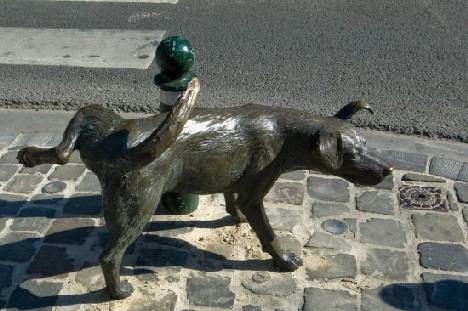At the intersection of Dubova and Bannaya Streets, in the heart of the Belgian capital, is one of the most famous world sculptures and, without a doubt, the most popular attraction in Brussels - the Manneken Pis fountain. It is a small statue of a little naked boy who pisses in the pool. And although similar compositions are available in other cities of the world (for example, Gerardsbergen, Hasselt, Ghent have their own “pissing boys”), thousands and thousands of tourists gather annually near the Brussels bronze sculpture. Undoubtedly, the Belgian Manneken Pis is the most famous in the world.
History
Many legends go around the origin of this statue, and the most common of them is associated with the name of Duke Godfrey the Third. During the Grimbergen War, when the army of the monarch Gottfried of Third Levensky fought the enemy, his two-year-old son (this was Duke Godfrey the Third) was hanged in a basket on a tree so that the view of the future ruler would inspire the townspeople. The child allegedly urinated from above on the soldiers who fought under the tree, and they lost the battle.
There is another version. Brussels was under siege in the 14th century, the enemies sought to lay explosives and blow up city walls. But they were followed by a little boy, whose name was Julian. The child peeed on a burning wick, thanks to which he put out the ammunition laid out by the enemy and saved the city.
However, there is another story telling about the origin of the sculpture "Manneken Pis". One day, a rich merchant lost a little son. We gathered a large group of people to search for him, searched every corner of the city. And then the child was found pissing in the garden. The merchant was immensely happy, and as a thank you to the locals decided to install a fountain in this place.
The author of the sculpture "Manneken Pis"
Where the truth is, and where is the fiction, hardly anyone will know now. It is only known for certain that the statue acquired its present form thanks to the skill of the court sculptor-mannerist Jerome Duchenoy in 1619. And since 1695, she was repeatedly abducted. Once this happened during the period of the Napoleonic troops in Brussels, and the last time the sculpture “Manneken Pis” was stolen in the 1960s, after which it was replaced, as before, with a copy. In 1908, a dumb French film was even shot about the pursuit of the statue kidnappers.
Traditions
With this fountain is connected a lot of all kinds of interesting traditions. For example, on holidays it is customary to replace a stream of water with beer or wine. Also, from time to time, the Manneken Pis statue is dressed in costumes. The first sculpture outfit, as the story goes, was created in 1968 by the Bavarian elector Maximilian-Emanuel, and since then it has turned not just into tradition, but into a kind of celebration of city guests.
Costume change
A monthly list of all the outfits that the Manneken Pis will change during the month is posted on the fountain grill. Several hundred various costumes include a statue wardrobe. All outfits are changed strictly in accordance with a list compiled by a nonprofit organization called Friends of the Pissing Boy. As a rule, a brass band plays at the ceremony of changing vestments, and the action turns into a real celebration. Not far from the sculpture, in the central city square, is the Royal Museum, which presents an exposition of outfits, numbering more than eight hundred copies. Many costumes are the national clothes of countries whose citizens visit the Belgian capital as tourists. Other vestments are a uniform of representatives of various professions, military services, associations and so on.
Diverse wardrobe
What did the statue of Manneken Pis don’t clothe! For example, in honor of the six-month presidency of the European Union, Hungary, the boy was dressed in a Hungarian hussar outfit. In 2004, with the initiative of Amnesty International, he was dressed in a soldier's uniform to draw attention to the problems of child soldiers. They also tried on the boy the costume of the Russian cosmonaut donated by the international space mission, the Santa Claus outfit, the attire of a urologist, the uniform of the United States Air Force cadet, the costume of a judo fighter, the outfits of Dracula and the Inca evil spirit, and many others.
Similar statues
It should be noted that, in an effort to maintain the glory of the fountain, Brussels established several similar compositions in the city. So, in 1987, near the “Manneken Pis”, at the end of the Alley of Fidelity, they put the “Manneken Pis”. According to one version, this statue was a parody of the world famous symbol of the city. The author of the sculpture is Denis Adrian Debouvry. The composition is a nude girl who pisses in the tank installed below. The statue for security purposes is located in a niche, which is surrounded by a lattice.

In the center of Brussels there is another similar sculpture. This is a bronze figurine of a purebred pissing dog, made in full size. The animal is depicted with a hind paw on the sidewalk. This composition was created in 1999 by the sculptor Tom Franzen. The mixed-breed dog, as the author testifies, symbolizes the unification of different cultures in Brussels. You can see the sculpture “Pissing dog” near the fountains “Pissing girl” and “Pissing boy”, which served as the idea for its creation. Here it is, Belgian art!